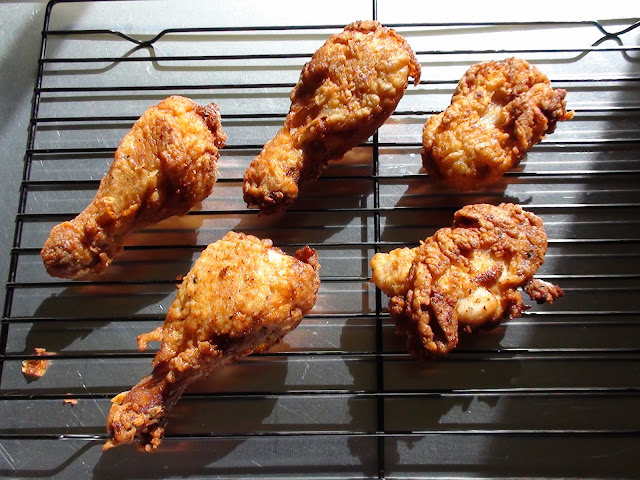The way fried chicken should
always taste!
I have been experimenting with
fried chicken for a long time. ‘Cause there are endless ways to ruin fried
chicken. From all the expert advice I found in cookbooks and on the web about
soaking, parboiling, sticking it in the micro or into the oven, cook it covered
or in a clunky deep fryer and still always, always I ended up with bleeding chicken.
Forget all the advice and just
once try it this way. I guarantee, you will never look for a fried chicken
recipe again.
Use only small, free range
chickens. Don’t fall for the “secret herbs and spices” claim, they are terrible.
Every one of them. Make sure everything is at room temperature, including the
chicken. Fry only room temperature chicken. Cold chicken fries unevenly. Brine
in real buttermilk, not in a mixture of substitutions. Shake the excess off before dropping in the coating.
tender, juicy and so delicious
PERFECT FRIED CHICKEN
10 to 12 free range chicken pieces,
at room temperature
1 litre of vegetable oil for
frying
Brine:
500 ml buttermilk, room
temperature
4 Tbsp hot sauce
1 Tbsp salt
1 Tbsp crushed garlic
1 Tbsp mustard paste
Coating:
1 cup flour
3 Tbsp corn flour
1-1/2 tsp baking powder
1 tsp black pepper
1 Tbsp chilli powder
1 Tbsp paprika
1 Tbsp brown sugar
1 Tbsp salt
1 Tbsp onion powder
1 Tbsp garlic powder
- The chicken and the buttermilk must be at room temperature. If you deep fry chilled chicken meat, it will cook unevenly. The outside will be burned and the inside will be still tough. NEVER deep fry chilled chicken.
- The recipe is for a dozen pieces of chicken. If you only fry a few pieces, reduce the brine and the coating ingredients as well as the oil and use a heavy skillet instead of a Dutch pot.
- Trim and wash the chicken pieces and pat dry with paper towels.
- In a bowl combine the brine ingredients.
- Add the chicken pieces to the brine, cover and let them soak for two hours. Do NOT refrigerate. You may brine the chicken overnight in the fridge, but when you take it out let everything come to room temperature. This will take longer than two hours.
- Next prepare the coating.
- Place all the ingredients in a large bowl and whisk to combine.
- Using a pair of kitchen thongs transfer one piece of chicken at a time to the bowl with the coating. Tilt the bowl and roll it around until the chicken is completely coated.
- Transfer to a wax paper lined baking tray and repeat procedure with the remaining chicken.
- Heat up the oil in a large Dutch pot on the medium setting. This takes a bit of time, but you don’t want the oil on too high, you want a steady frying temperature between low medium, medium or high medium.
- Using a pair of kitchen thongs lower a piece of chicken into the hot oil. Don’t just drop it in the hot oil because it will splatter up and hit you on the face. Let the piece fry for a couple of minutes and gently flip it over with a fork. Do not pierce the meat. Refrain from using the thongs for turning, the coating is fragile at this stage and comes off easily.
- One by one add another piece of chicken to the pot and fry it just as the one before. Don’t fry more than five pieces of chicken. Too many pieces will build up steam, besides the coating will come off if the pot is overcrowded.
- Fry for ~20 minutes or until every piece of chicken is golden brown and crispy. Remove the finished chicken with the kitchen thongs, they are less fragile than during frying.
- Transfer the chicken to a wire rack. Do not put the hot chicken on paper towels or the undersides will get soggy. If you have a large batch to fry, place the wire rack with a catch tray in the preheated 200F [not Celsius!] oven until all the pieces are done.
- When the last piece of chicken is fried, set them out on the counter with the wire rack for a 10 minute rest. This will conclude the process allowing the fibers to relax.






